|
Wesleyan
Methodist chapels in the Potteries
Jubilee Chapel, Tunstall -
"the Mother Church"
About 1783 a Methodist
society was established at the house of Joseph Smith, attached to the
Burslem society. By 1775 it had 30 members and in 1787 a fund for a chapel
was raised by John Wesley, the site being given by Joseph Smith.
The chapel was erected at a
cost of £650 and was opened in 1788. Wesley on visiting it in 1790
declared that it was 'the most elegant I have seen since I left Bath'.
'1790,
Monday, March 29th - At nine I preached in the new chapel
at Tunstall, the most elegant I have seen since I left Bath. The people
seemed to devour the word."
Discontent arose in the early
days of the society over Wesley's ruling that only Church of England
prayers were to be used. It was more seriously disturbed from 1808 to 1813
by the growth of the Camp Meeting Movement (which led to the Primitive
Methodist movement) in the area and in 1811 the society expelled its
steward and Sunday School superintendent, James Steele, one of the leaders
of this movement and subsequently a founder of the Primitive Methodist
Connexion.
The establishment of that
Connexion, however, was only a temporary setback and by 1834 the chapel
was too small for the society. A new chapel in Wesley Place was then begun
and officially opened in March of the following year. In 1839 it became
head of the newly created Tunstall Wesleyan Circuit. Attendance in
1851 averaged 300 in the morning and 520 in the afternoon. In 1958
it had 176 members. The chapel had a brick pedimented front and was dated
1834 and has a stone porch of three bays supported on Roman Doric columns.
In 1869 it was reseated; in 1890 new windows were inserted and in 1898 an
organ was installed.
A Sunday school was started in 1799 which met until
1816 in the chapel. A school building was then erected in America Street.
An additional wing was added in 1832, but in 1835 the school moved into
the old chapel. In 1838 new schools near Wesley Place Chapel in Farndale
Street were opened. Reading and writing were taught in the Sunday school
until c. 1844 when a Wesleyan day school was established. A night school
for general educational purposes in connexion with the Sunday school was
established c. 1834 and lasted until 1874
From: A History of
the County of Stafford: Volume 8 (1963).
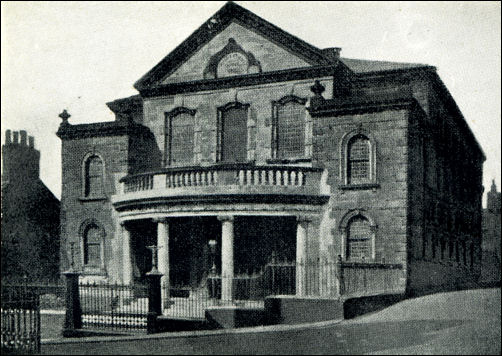
Jubilee Chapel, Wesley
Street, Tunstall - "the Mother Church"
The chapel, a building in
the Gothic style with a turret on its south-east side, was then the
only place of worship in Tunstall and the largest Methodist chapel in the
Potteries. It stood at the corner of America Street and Temple Street (renamed
to Buren Street and later to Holland Street)
by the windmill.

Etruria Wesleyan Methodist Chapel
Meetings of Methodists in Etruria took place in private
houses in the village in the late 18th century. The first Wesleyan chapel
was built in 1808 in a field south of Etruria and stood on the site
of the colour works of Wengers Ltd.
In 1820 it was replaced by a new chapel on the main
road near the centre of the village which is still standing. This is a
brick building with a classical plastered front surmounted by a pediment
and a date tablet illustrated in the photos below.
In 1851
attendance at the Wesleyan chapel averaged 140 and at the Sunday school
180. The chapel, which stands in Lord Street (now Etruria Road), seated
428 in 1940, and is a brick building with a Classical plastered front
surmounted by a pediment and a date tablet.
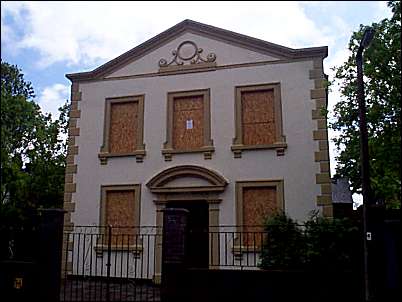
Etruria Wesleyan
Methodist Chapel, dated 1820
Non-conformist chapel built 1820, two
story, developed by Josiah Wedgwood
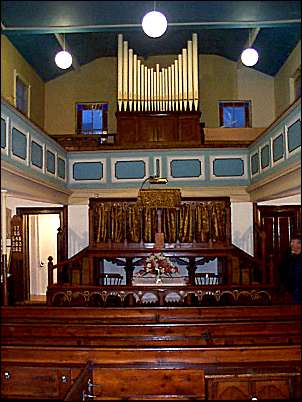
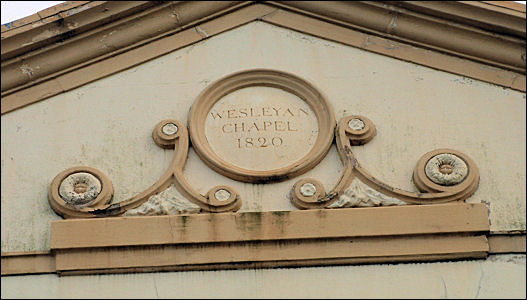
date tablet
Wesleyan Chapel 1820
 more on the Etruria
Methodist Chapel
more on the Etruria
Methodist Chapel

Temple Street
Wesleyan
Methodist Chapel, Fenton
A Wesleyan Methodist
chapel was built in Temple Street in 1812. In 1851 it seated 300 and had
an attendance on 30 March 1851 of 65 in the morning and 85 in the evening.
A new chapel (see photo
below) was erected in 1873 which seated 600 in 1940. It had a membership
of 166 in 1942 .

Temple Street
Wesleyan
Methodist Chapel, Fenton,
built 1873
photo:
© Stoke-on-Trent Museum and Art
Gallery

Swan Bank Wesleyan
Chapel, Burslem
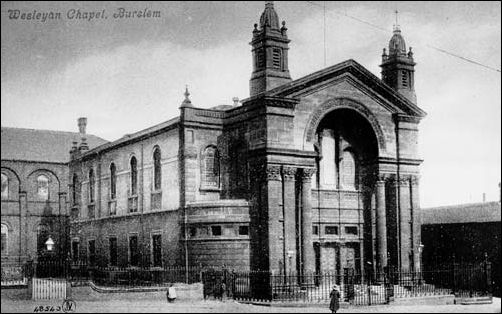
Swan Bank Wesleyan
Chapel, Burslem c.1890-1895
"the Corinthian facade of the Wesleyan Chapel"
Description:
"Three times on a Sunday - morning, afternoon, and Chapel at night..."
The first Wesleyan Chapel was built in the Potteries in 1766.
This was replaced by Swan Bank Chapel, shown in the photograph, in 1801.
In 1816 it was enlarged to seat 1290 people, before eventually being
replaced in 1971.
photo: © Potteries Museum
& Art Gallery
Staffordshire Past Track

Botteslow
Street Wesleyan Chapel, Hanley
An iron chapel was erected
in Botteslow Street in 1880 by Isaac Dixon, a mineral-water manufacturer.
There was a Sunday school by 1890 when permission was given to enlarge it.
The present chapel was built in 1906. It seated 200 in 1940
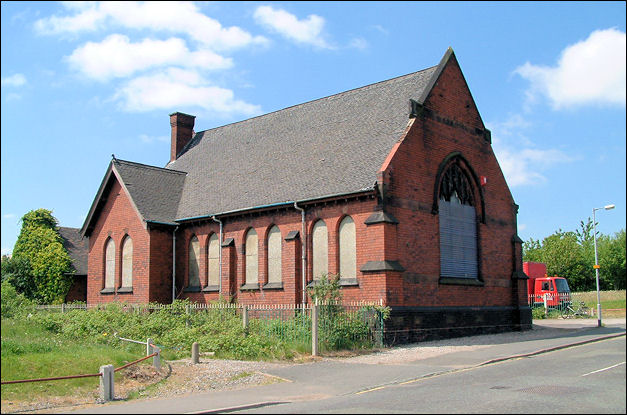
Botteslow Street Wesleyan
Chapel, Hanley
built - 1906

|
![]()
![]()
![]()
![]()
![]()
![]()